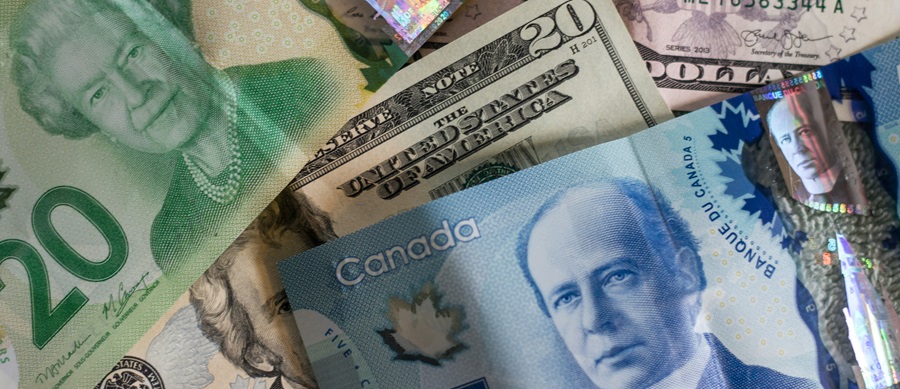
It’s that time of year when many Canadians are flocking to the U.S. Sometimes for sunshine, sometimes for shopping – usually for warmth. Unfortunately, the current exchange rate isn’t ideal. To find out the day’s rate, the Bank of Canada’s Currency Converter is a good place to start to see what you’re working with; a benchmark for reference when shopping around for a better rate.
As of January 29, 2024, the value of $1 Canadian dollar is around US$0.7424. Historically, the value of the Canadian dollar is hovering in the middle. In late 2007, the CAD hit its modern-day intraday high of US$1.10. Previously, in early 2002, the CAD hit its all-time low against the US dollar dropping to US$0.6179.
So, what should you do? Exchange the money now, put it in a U.S. account, or use a credit card? Let’s see:
What’s a Spread?
The difference between the price the exchange or bank paid for the currency and the inflated price at which they are going to sell it, is called the spread. The spread is usually included in the total exchange rate that is offered to you.
Why are Some Places Listed as a “Free Exchange?”
Of course, sadly, nothing is free. These types of businesses inflate the exchange rate to generate profit. There are no “extra fees” listed on the final receipt, but you’re paying for the services buried within the inflated exchange rate. These businesses (usually kiosks) pop up at airports, train stations or touristy areas, and they should come with a sign: BUYER BEWARE. Of course, if you’re in a pinch it’s fine to convert a small amount of money.
Where to Convert Money?
There are some tried and true ways to convert currency. Here are four:
- Banks- Currency exchange rates and fees differ between the Big Canadian Banks, but not significantly. The service fee is between 1%-3%.
- Exchanges- Currency-exchange services tend to offer a slightly better deal than the banks, such as the Vancouver Bullion & Currency Exchange (VBCE), and usually have best-rate guarantees. So, if a bank offers you a rate, you can show the VBCE and get a better rate.
- Credit Cards - If you use your Canadian credit card outside of Canada or for any foreign currency transactions, you pay a foreign currency conversion fee of 2.5%. If you travel between Canada and the U.S. often the Home Trust Preferred Visa is an excellent option. It’s a true no-foreign-exchange-fee card. Here’s a list of the Best No Foreign Transaction Fee Cards, recently put together by MoneySense.
- ATMs
A Note on Converting Money at an ATM
Sure, ATMs are often convenient, but there are a few things to keep in mind:
- Pros: ATMs use the exchange rate of the day. So, at least you know you’re getting the true rate.
- Cons: Many ATMs charge exorbitant fees. Ranging from transaction fee (common at international ATMs not in your network), a conversion fee, plus a surcharge.
All ATMs run on a network, so check online to see if your bank suggests certain ATMs that waive some of these fees, likely it’ll be one in their network.
A True Currency Exchange Story: From Las Vegas to Winnipeg to Vancouver
*Debbie, from a small town in Manitoba, sells a US$400,000 condo in Las Vegas. She calls her financial advisor to figure out how to convert the money, and he says, “Shop around for the best rate.”
She calls her local banker, and he offers $1.32 CAD. She says no. “I flew the next day to Vancouver to visit my daughter and went to the CIBC downtown,” she says. The branch offered her a similar rate. However, they suggested going down the road to the VBCE to see what they’re offering. And then to bring that rate back to the bank.
So, she did. The VBCE wrote down their rate: $1.356 CAD. She took that number back to the Vancouver branch the next day. Unfortunately, The Bank of Canada rate had fallen slightly, but CIBC still offered her very close to the VCBE exchange rate.
She saved over $25,000 by shopping around. And as Debbie’s financial advisor says, “Remember different banks give different rates.” Her small-town local branch wouldn’t negotiate; but the city branch did.
*Debbie prefers not to use her last name





:quality(80)/cloudfront-us-east-1.images.arcpublishing.com/morningstar/6ZMXY4RCRNEADPDWYQVTTWALWM.jpg)
:quality(80)/cloudfront-us-east-1.images.arcpublishing.com/morningstar/UEGBDMVEKZHSPOTU7BXUZMQEQA.jpg)
:quality(80)/cloudfront-us-east-1.images.arcpublishing.com/morningstar/MNPB4CP64NCNLA3MTELE3ISLRY.jpg)
:quality(80)/cloudfront-us-east-1.images.arcpublishing.com/morningstar/G3DCA6SF2FAR5PKHPEXOIB6CWQ.jpg)











